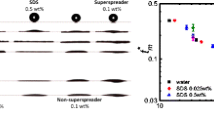Abstract
Surfactant monolayers were formed on a water surface and subjected to water drops falling from a nozzle. Surface tension was measured during these experiments to determine the effect of the drop impacts on the surfactant monolayer. The purpose of this work was to determine whether monolayers can be altered by drop impacts without the formation of a splash. Accordingly, a small fall height was used to avoid drop splashes and concomitant surfactant loss by droplet ejection. The relevance of this work pertains to the fate of surfactant monolayers during rain events. Results are presented for a soluble and insoluble surfactant. The results show that the insoluble monolayer is virtually unaffected by the drops, indicating that the monolayer immediately reforms after the drop impact. The soluble monolayer shows significant changes in measured surface tension during droplet impact when the surfactant concentration is high.






Similar content being viewed by others
References
Adamson AW (1990) Physical chemistry of surfaces. Wiley, New York
Baier RE, Goupil DW, Perlmutter S, King R (1974) Dominant chemical composition of sea-surface films, natural slicks, and foams. J Rech Atmos 60:507–513
Barger WR (1991) A review of experimental observations and remaining questions concerning formation, persistence, and disappearance of sea slicks. NRL Report 9313. Naval Research Laboratory, Washington, DC
Barnes GT (1986) The effects of monolayers on the evaporation of liquids. Adv Colloid Interface Sci 25:189–200
Barnes GT (1997) Permeation through monolayers. Colloids Surf A: Physiochem Eng Aspects 126:149–158
Barnes GT, Feher AI (1980) The measurement of temperature gradients in water during evaporation through monolayer-free and monolayer-covered surfaces. J Colloid Interface Sci 75:584–589
Frew NM (1997) The role of organic films in air-sea gas exchange. In: Liss PS, Duce RA (eds) The Sea Surface and Global Change. Cambridge University Press, New York, pp 121–171
Frew NM, Goldman JC, Dennett MR, Johnson AS (1990) Impact of phytoplankton-generated surfactants on air-sea gas-exchange. J Geophys Res Oceans 95:3337–3352
Gaines GL Jr (1966) Insoluble monolayers at liquid-gas interfaces. Wiley, New York
Garrett WD, Zisman WA (1970) Damping of capillary waves on water by monomolecular films of linear polyorganosiloxanes. J Phys Chem 74:1796–1805
Goldman JC, Dennett MR, Frew NM (1988) Surfactant effects on air sea gas-exchange under turbulent conditions. Deep Sea Res 35:1953–1970
Green T, Houk DF (1979) The removal of organic surface films by rain. Limnol Oceanogr 24:966–970
Henderson DM (1998) Effects of surfactants on Faraday-wave dynamics. J Fluid Mech 365:89–107
Jarvis NL (1962) The effect of monomolecular films on surface temperature and convective motion at the water/air interface. J Colloid Sci 17:512–522
Jarvis NL, Kagarise RE (1962) Determination of the surface temperature of water during evaporation studies: a comparison of thermistor with infrared radiometer measurements. J Colloid Sci 17:501–511
Jarvis NL, Timmons CO, Zisman WA (1962) The effect of monomolecular films on the surface temperature of water. In: La Mer VK (ed) Retardation of evaporation by monolayers. Academic Press, New York, pp 41–58
Jiang Q, Chiew YC, Valentini JE (1992) Damping of cylindrical propagating capillary waves on monolayercovered surfaces. Langmuir 8:2747–2752
La Mer VK (1962) Retardation of evaporation by monolayers: transport processes. Academic Press, New York
Lange PA, v.d. Graaf G , Gade M (2000) Rain-induced subsurface turbulence measured using image processing methods. In: Proceedings of the International Geoscience and Remote Sensing Symposium (IGARSS), Volume VII, Honolulu, Hawaii, pp 3175–3177
Lapham GS, Dowling DR, Schultz WW (2001) Linear and nonlinear gravity-capillary water waves with a soluble surfactant. Exp Fluids 30:448–457
Lucassen J, Hansen RS (1966) Damping of waves on monolayer-covered surfaces. I. Systems with negligible surface dilational viscosity. J Colloid Int Sci 22:32–44
Mann JA, Ahmad J (1969) Dynamic surface tension: ripple damping. J Colloid Int Sci 29:158–161
Milgram JH (1998) Short wave damping in the simultaneous presence of a surface film and turbulence. J Geophys Res 103:15717–15727
Monahan EC, Dam HG (2001) Bubbles: an estimate of their role in the global oceanic flux of carbon. J Geophys Res 106:9377–9383
Navon U, Fenn JB (1971) Interfacial mass and heat transfer during evaporation. II. Effect of monomolecular films on natural convection in water. AIChE J 17:137–140
Noskov BA (1988) Influence of a monolayer of stearic acid on damping of capillary waves. Kolloidn Zh 50:1201–1205
Rideal EK (1925) On the influence of thin surface films on the evaporation of water. J Phys Chem 29:1585–1588
Rodriguez F, Mesler R (1988) The penetration of drop-formed vortex rings into pools of liquid. J Colloid Interface Sci 121:121–129
Saylor JR, Handler RA (1999) Capillary wave gas exchange in the presence of surfactants. Exp Fluids 27:332–338
Saylor JR, Smith GB, Flack KA (2000a) The effect of a surfactant monolayer on the temperature field of a water surface undergoing evaporation. Int J Heat Mass Transfer 43:3073–3086
Saylor JR, Smith GB, Flack KA (2000b) Infrared imaging of the surface temperature field of water during film spreading. Phys Fluids 12:597–602
Saylor JR, Smith GB, Flack KA (2001) An experimental investigation of the surface temperature field during evaporative convection. Phys Fluids 13:428–439
Schlüssel P, Soloviev A, Emery WJ (1997) Cool and freshwater skin of the ocean during rainfall. Boundary Layer Meteorol 82:437–442
Skop RA, Lindsley WG, Brown JW (1991) Radiotracer studies of surfactant transport to the sea-air interface by submillimeter-size bubbles. Exp Fluids 10:251–256
Skop RA, Viechnicki JT, Brown JW (1994) A model for microbubble scavenging of surface-active lipid molecules from seawater. J Geophys Res 99:16395–16402
Stefan RL, Szeri AJ (1999) Surfactant scavenging and surface deposition by rising bubbles. J Colloid Interface Sci 212:113
Szeri AJ, Stefan RL, Saylor JR (2001) Surfactant scavenging by microbubble clouds: consequences for capillary wave damping. In: Fluid Mechanics and the Environment: Dynamical Approaches, Lecture Notes in Physics. Springer, Berlin Heidelberg New York
Acknowledgements
Financial support from the Office of Naval Research through the Naval Research Laboratory is gratefully acknowledged.
Author information
Authors and Affiliations
Corresponding author
Rights and permissions
About this article
Cite this article
Saylor, J.R. The fate of soluble and insoluble surfactant monolayers subjected to drop impacts. Exp Fluids 34, 540–547 (2003). https://doi.org/10.1007/s00348-002-0569-6
Received:
Accepted:
Published:
Issue Date:
DOI: https://doi.org/10.1007/s00348-002-0569-6




